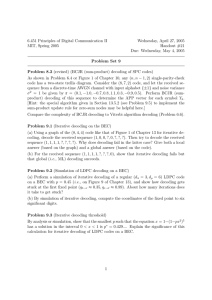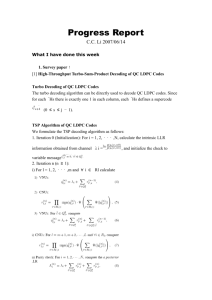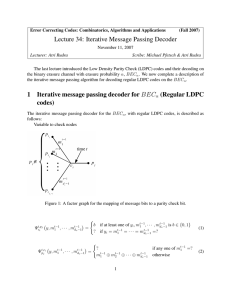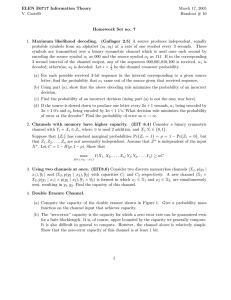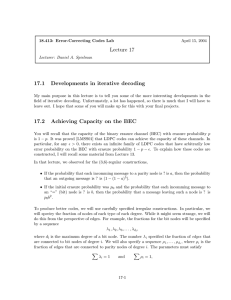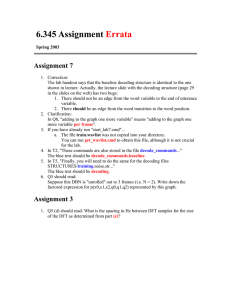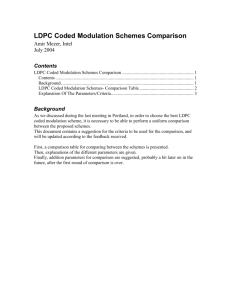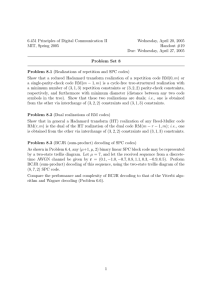Capacity-approaching codes Chapter 13
advertisement
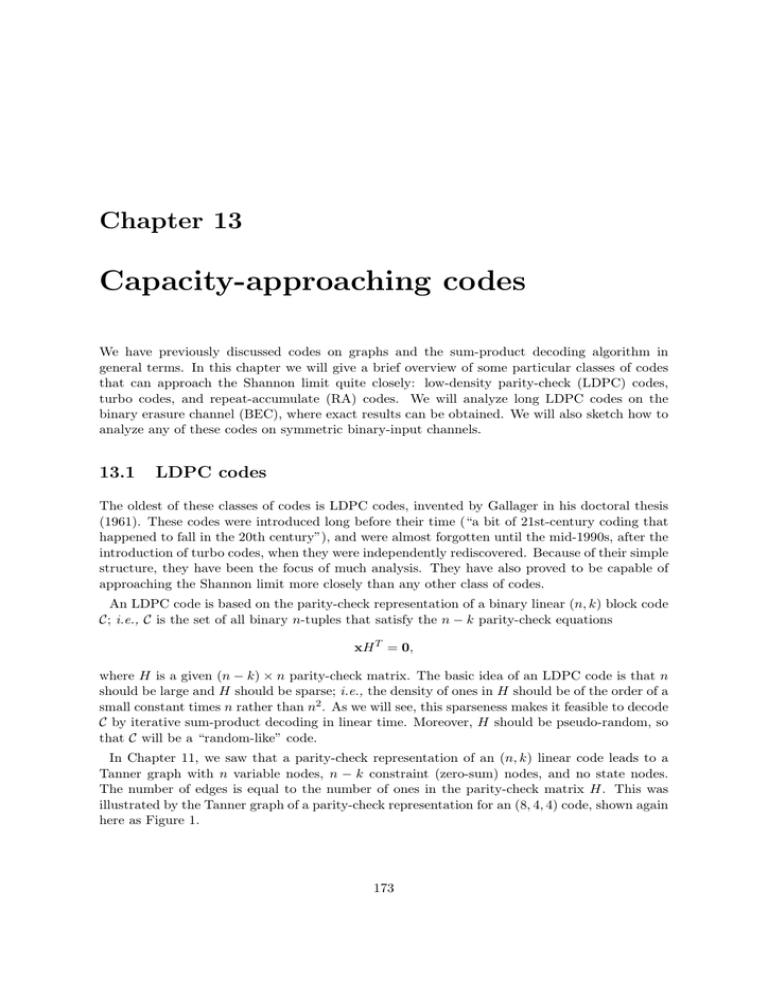
Chapter 13
Capacity-approaching codes
We have previously discussed codes on graphs and the sum-product decoding algorithm in
general terms. In this chapter we will give a brief overview of some particular classes of codes
that can approach the Shannon limit quite closely: low-density parity-check (LDPC) codes,
turbo codes, and repeat-accumulate (RA) codes. We will analyze long LDPC codes on the
binary erasure channel (BEC), where exact results can be obtained. We will also sketch how to
analyze any of these codes on symmetric binary-input channels.
13.1
LDPC codes
The oldest of these classes of codes is LDPC codes, invented by Gallager in his doctoral thesis
(1961). These codes were introduced long before their time (“a bit of 21st-century coding that
happened to fall in the 20th century”), and were almost forgotten until the mid-1990s, after the
introduction of turbo codes, when they were independently rediscovered. Because of their simple
structure, they have been the focus of much analysis. They have also proved to be capable of
approaching the Shannon limit more closely than any other class of codes.
An LDPC code is based on the parity-check representation of a binary linear (n, k) block code
C; i.e., C is the set of all binary n-tuples that satisfy the n − k parity-check equations
xH T = 0,
where H is a given (n − k) × n parity-check matrix. The basic idea of an LDPC code is that n
should be large and H should be sparse; i.e., the density of ones in H should be of the order of a
small constant times n rather than n2 . As we will see, this sparseness makes it feasible to decode
C by iterative sum-product decoding in linear time. Moreover, H should be pseudo-random, so
that C will be a “random-like” code.
In Chapter 11, we saw that a parity-check representation of an (n, k) linear code leads to a
Tanner graph with n variable nodes, n − k constraint (zero-sum) nodes, and no state nodes.
The number of edges is equal to the number of ones in the parity-check matrix H . This was
illustrated by the Tanner graph of a parity-check representation for an (8, 4, 4) code, shown again
here as Figure 1.
173
CHAPTER 13. CAPACITY-APPROACHING CODES
174
x0 ~
H
x1
x2
x3
x4
x5
x6
x7
HH
HH
~
X
H
HX
X
HHXXXHH
XXH
H
XX
H
HH
~
HH
H
HH
H
HH
HH
~
X
XXX
H
X
H
X
X
HH
X
X
X
X
~
X
XX X
X
XXX
X
~
~
~
+
+
+
+
Figure 1. Tanner graph of parity-check representation for (8, 4, 4) code.
Gallager’s original LDPC codes were regular, meaning that every variable is involved in the
same number dλ of constraints, whereas every constraint checks the same number dρ of variables,
where dρ and dλ are small integers. The number of edges is thus ndλ = (n − k)dρ , so the nominal
rate R = k/n of the code satisfies1
1−R=
dλ
n−k
.
=
n
dρ
Subject to this constraint, the connections between the ndλ variable “sockets” and the (n − k)dρ
constraint sockets are made pseudo-randomly.
For example, the normal graph of a Gallager code with dλ = 3, dρ = 6 and R = 21 is shown in
Figure 2. The large box labelled Π represents a pseudo-random permutation (“interleaver”).
=
PP
H
P
h
h
P
H
(
(
+
=
P
P
=
P
P
H
P
h
h
P
H
(
(
+
=
PP
Π
...
=
P
P
=P
P
...
H
P
h
h
P
H
(
(
+
Figure 2. Normal graph of a regular dλ = 3, dρ = 6 LDPC code.
1
The actual rate of the code will be greater than R if the checks are not linearly independent. However, this
fine point may be safely ignored.
13.2. TURBO CODES
175
Decoding an LDPC code is done by an iterative version of the sum-product algorithm, with a
schedule that alternates between left nodes (repetition constraints) and right nodes (zero-sum
constraints). The sparseness of the graph tends to insure that its girth (minimum cycle length)
is reasonably large, so that the graph is locally tree-like. In decoding, this implies that the
independence assumption holds for quite a few iterations. However, typically the number of
iterations is large, so the independence assumption eventually becomes invalid.
The minimum distance of an LDPC code is typically large, so that actual decoding errors
are hardly ever made. Rather, the typical decoding failure mode is a failure of the decoding
algorithm to converge, which is of course a detectable failure.
The main improvement in recent years to Gallager’s LDPC codes has been the use of irregular codes— i.e., LDPC codes in which the left (variable) vertices and right (check) vertices
have arbitrary degree distributions. The behavior of the decoding algorithm can be analyzed
rather precisely using a technique called “density evolution,” and the degree distributions can
consequently be optimized, as we will discuss later in this chapter.
13.2
Turbo codes
The invention of turbo codes by Berrou et al. (1993) ignited great excitement about capacityapproaching codes. Initially, turbo codes were the class of capacity-approaching codes that were
most widely used in practice, although LDPC codes may now be superseding turbo codes. Turbo
codes achieve fairly low error rates within 1–2 dB of the Shannon limit at moderate block lengths
(n = 103 to 104 ).
The original turbo codes of Berrou et al. are still some of the best that are known. Figure 3
shows a typical Berrou-type turbo code. An information bit sequence is encoded twice: first by
an ordinary rate- 21 systematic recursive (with feedback) convolutional encoder, and then, after a
large pseudo-random permutation Π, by a second such encoder. The information sequence and
the two parity sequences are transmitted, so the overall rate is R = 13 .
information bits rate- 21 , 4–16-state
- systematic recursive
?
first parity bits -
convolutional encoder
Π
rate- 21 , 4–16-state
- systematic recursive
second parity bits-
convolutional encoder
Figure 3. Rate- 13 Berrou-type turbo code.
The two convolutional encoders are not very complicated, typically 4–16 states, and are often
chosen to be identical. The convolutional codes are usually terminated to a finite block length.
In practice the rate is often increased by puncturing.
CHAPTER 13. CAPACITY-APPROACHING CODES
176
info bits
=
first
parity
bits
second
parity
bits
=
=
=
...
...
Π
...
=
=
trellis 1
trellis 2
Figure 4. Normal graph of a Berrou-type turbo code.
Figure 4 is a normal graph of such a code. On both sides of the permutation Π are normal
graphs representing the trellises of the two constituent convolutional codes, as in Figure 4(b)
of Chapter 11. The information and parity bits are shown separately. The information bit
sequences for the two trellises are identical, apart from the permutation Π.
Decoding a turbo code is done by an iterative version of the sum-product algorithm, with a
schedule that alternates between the left trellis and the right trellis. On each trellis the sumproduct algorithm reduces to the BCJR (APP) algorithm, so the decoder can efficiently decode
the entire trellis before exchanging the resulting “extrinsic information” with the other trellis.
Again, the large permutation Π, combined with the recursive property of the encoders, tends
to ensure that the girth of the graph is reasonably large, so the independence assumption holds
for quite a few iterations. In turbo decoding the number of iterations is typically only 10–20,
since much computation can be done along a trellis in each iteration.
The minimum distance of a Berrou-type turbo code is typically not very large. Although at
low SNRs the decoding error probability tends to drop off rapidly above a threshold SNR (the
“waterfall region”) down to 10−4 , 10−5 or lower, for higher SNRs the error probability falls off
more slowly due to low-weight error events (the “noise floor” region), and the decoder actually
makes undetectable errors.
For applications in which these effects are undesirable, a different arrangement of two constituent codes is used, namely one after the other as in classical concatenated coding. Such
codes are called “serial concatenated codes,” whereas the Berrou-type codes are called “parallel
concatenated codes.” Serial concatenated codes usually still have an error floor, but typically
at a considerably lower error rate than parallel concatenated codes. On the other hand, their
threshold in the waterfall region tends to be worse than that of parallel concatenated codes.
The “repeat-accumulate” codes of the next section are simple serial concatenated codes.
Analysis of turbo codes tends to be more ad hoc than that of LDPC codes. However, good ad
hoc techniques for estimating decoder performance are now known (e.g., the “extrinsic information transfer (EXIT) chart;” see below), which allow optimization of the component codes.
13.3. REPEAT-ACCUMULATE CODES
13.3
177
Repeat-accumulate codes
Repeat-accumulate (RA) codes were introduced by Divsalar, McEliece et al. (1998) as extremely
simple “turbo-like” codes for which there was some hope of proving theorems. Surprisingly, even
such simple codes proved to work quite well, within about 1.5 dB of the Shannon limit— i.e.,
better than the best schemes known prior to turbo codes.
RA codes are a very simple class of serial concatenated codes. The outer code is a simple
(n, 1, n) repetition code, which simply repeats the information bits n times. The resulting
sequence is then permuted by a large pseudo-random permutation Π. The inner code is a rate-1
2-state convolutional code with generator g(D) = 1/(1 + D); i.e., the input/output equation is
yk = xk + yk−1 , so the output bit is simply the “accumulation” of all previous input bits (mod
2). The complete RA encoder is shown in Figure 5.
- (n, 1, n)
- Π
-
1
1+D
-
Figure 5. Rate- n1 RA encoder.
The normal graph of a rate- 31 RA code is shown in Figure 6. Since the original information
bits are not transmitted, they are regarded as hidden state variables, repeated three times. On
the right side, the states of the 2-state trellis are the output bits yk , and the trellis constraints
are represented explicitly by zero-sum nodes that enforce the constraints yk + xk + yk−1 = 0.
...
...
=
+
�
=
�
=�
+
@
@
=
@
+
Π
=
+
�
�
=�
+
@
@
@
...
=
=
+
...
Figure 6. Normal graph of rate- 31 RA code.
Decoding an RA code is again done by an iterative version of the sum-product algorithm,
with a schedule that alternates between the left constraints and the right constraints, which in
this case form a 2-state trellis. For the latter, the sum-product algorithm again reduces to the
BCJR (APP) algorithm, so the decoder can efficiently decode the entire trellis in one iteration.
A left-side iteration does not accomplish as much, but on the other hand it is extremely simple.
As with LDPC codes, performance may be improved by making the left degrees irregular.
178
13.4
CHAPTER 13. CAPACITY-APPROACHING CODES
Analysis of LDPC codes on the binary erasure channel
In this section we will analyze the performance of iterative decoding of long LDPC codes on
a binary erasure channel. This is one of the few scenarios in which exact analysis is possible.
However, the results are qualitatively (and to a considerable extent quantitatively) indicative of
what happens in more general scenarios.
13.4.1
The binary erasure channel
The binary erasure channel (BEC) models a memoryless channel with two inputs {0, 1} and
three outputs, {0, 1, ?}, where “?” is an “erasure symbol.” The probability that any transmitted
bit will be received correctly is 1 − p, that it will be erased is p, and that it will be received
incorrectly is zero. These transition probabilities are summarized in Figure 7 below.
p
0 XX1X−
p X 0
X
X
p ?
1
1
1−p
Figure 7. Transition probabilities of the binary erasure channel.
The binary erasure channel is an exceptional channel, in that a received symbol either specifies
the transmitted symbol completely, or else gives no information about it. There are few physical
examples of such binary-input channels. However, a Q-ary erasure channel (QEC) is a good
model of packet transmission on the Internet, where (because of internal parity checks on packets)
a packet is either received perfectly or not at all.
If a code sequence c from a binary code C is transmitted over a BEC, then the received
sequence r will agree with c in all unerased symbols. If there is no other code sequence c ∈ C
that agrees with r in all unerased symbols, then c is the only possible transmitted sequence,
so a maximum-likelihood (ML) decoder can decide that c was sent with complete confidence.
On the other hand, if there is another code sequence c ∈ C that agrees with r in all unerased
symbols, then there is no way to decide between c and c , so a detectable decoding failure must
occur. (We consider a random choice between c and c to be a decoding failure.)
The channel capacity of a BEC with erasure probability p is 1 − p, the fraction of unerased
symbols, as would be expected intuitively. If feedback is available, then the channel capacity
may be achieved simply by requesting retransmission of each erased symbol (the method used
on the Internet Q-ary erasure channel).
Even without feedback, if we choose the 2nR code sequences in a block code C of length n
and rate R independently at random with each bit having probability 12 of being 0 or 1, then as
n → ∞ the probability of a code sequence c ∈ C agreeing with the transmitted sequence c in all
≈ n(1 − p) unerased symbols is about 2−n(1−p) , so by the union bound estimate the probability
of decoding failure is about
Pr(E) ≈ 2nR · 2−n(1−p) ,
which decreases exponentially with n as long as R < 1 − p. Thus capacity can be approached
arbitrarily closely without feedback. On the other hand, if R > 1 − p, then with high probability
there will be only ≈ n(1 − p) < nR unerased symbols, which can distinguish between at most
2n(1−p) < 2nR code sequences, so decoding must fail with high probability.
13.4. ANALYSIS OF LDPC CODES ON THE BINARY ERASURE CHANNEL
13.4.2
179
Iterative decoding of LDPC codes on the BEC
On the binary erasure channel, the sum-product algorithm is greatly simplified, because at any
time every variable corresponding to every edge in the code graph is either known perfectly
(unerased) or not known at all (erased). Iterative decoding using the sum-product algorithm
therefore reduces simply to the propagation of unerased variables through the code graph.
There are only two types of nodes in a normal graph of an LDPC code (e.g., Figure 2):
repetition nodes and zero-sum nodes. If all variables are either correct or erased, then the
sum-product update rule for a repetition node reduces simply to:
If any incident variable is unerased, then all other incident variables may be set equal to
that variable, with complete confidence; otherwise, all incident variables remain erased.
For a zero-sum node, the sum-product update rule reduces to:
If all but one incident variable is unerased, then the remaining incident variable may
be set equal to the mod-2 sum of those inputs, with complete confidence; otherwise,
variable assignments remain unchanged.
Since all unerased variables are correct, there is no chance that these rules could produce a
variable assignment that conflicts with another assignment.
Exercise 1. Using a graph of the (8, 4, 4) code like that of Figure 1 for iterative decoding,
decode the received sequence (1, 0, 0, ?, 0, ?, ?, ?). Then try to decode the received sequence
(1, 1, 1, 1, ?, ?, ?, ?). Why does decoding fail in the latter case? Give both a local answer (based on
the graph) and a global answer (based on the code). For the received sequence (1, 1, 1, 1, ?, ?, ?, 0),
show that iterative decoding fails but that global (i.e., ML) decoding succeeds.
13.4.3
Performance of large random LDPC codes
We now analyze the performance of iterative decoding for asymptotically large random LDPC
codes on the BEC. Our method is a special case of a general method called density evolution, and
is illustrated by a special case of the EXtrinsic Information Transfer (EXIT) chart technique.
We first analyze a random ensemble of regular (dρ , dλ ) LDPC codes of length n and rate
R = 1 − dλ /dρ . In this case all left nodes are repetition nodes of degree dλ + 1, with one
external (input) incident variable and dλ internal (state) incident variables, and all right nodes
are zero-sum nodes of degree dρ , with all incident variables being internal (state) variables. The
random element is the permutation Π, which is chosen equiprobably from the set of all (ndλ )!
permutations of ndλ = (n − k)dρ variables. We let n → ∞ with (dρ , dλ ) fixed.
We use the standard sum-product algorithm, which alternates between sum-product updates
of all left nodes and all right nodes. We track the progress of the algorithm by the expected
fraction q of internal (state) variables that are still erased at each iteration. We will assume
that at each node, the incident variables are independent of each other and of everything else;
as n → ∞, this “locally tree-like” assumption is justified by the large random interleaver.
At a repetition node, if the current probability of internal variable erasure is qin , then the
probability that a given internal incident variable will be erased as a result of its sum-product
update is the probability that both the external incident variable and all dλ − 1 other internal
incident variables are erased, namely qout = p(qin )dλ −1 .
CHAPTER 13. CAPACITY-APPROACHING CODES
180
On the other hand, at a zero-sum node, the probability that a given incident variable will
not be erased is the probability that all dρ − 1 other internal incident variables are not erased,
namely (1 − qin )dρ −1 , so the probability that it is erased is qout = 1 − (1 − qin )dρ −1 .
These two functions are plotted in the “EXIT chart” of Figure 8 in the following manner. The
two variable axes are denoted by qr→ and q→r , where the subscripts denote respectively leftgoing and right-going erasure probabilities. The range of both axes is from 1 (the initial value)
to 0 (hopefully the final value). The two curves represent the sum-product update relationships
derived above:
q→r = p(qr→ )dλ −1 ;
qr→ = 1 − (1 − q→r )dρ −1 .
These curves are plotted for a regular (dλ = 3, dρ = 6) (R =
p = 0.4.
1
2)
LDPC code on a BEC with
0
p = 0.4
0.4
q→r
1
1
qr→
0
Figure 8. EXIT chart for iterative decoding of a regular (dλ = 3, dρ = 6) LDPC code on a BEC
with p = 0.4.
A “simulation” of iterative decoding may then be performed as follows (also plotted in Figure
8). Initially, the left-going erasure probability is qr→ = 1. After a sum-product update in the
left (repetition) nodes, the right-going erasure probability becomes q→r = p = 0.4. After a
sum-product update in the right (zero-sum) nodes, the left-going erasure probability becomes
qr→ = 1 − (0.6)5 = 0.922. Continuing, the erasure probability evolves as follows:
qr→ : 1
q→r :
0.922 0.875 0.839 0.809 0.780 0.752 0.723 0.690 0.653 0.607 0.550 0.475 0.377 . . .
R �
@
@
R �
@
R �
@
R �
@
R �
@
R �
@
R �
@
R �
@
R �
@
R �
@
R �
@
R �
@
R �
@
R �
0.400 0.340 0.306 0.282 0.262 0.244 0.227 0.209 0.191 0.170 0.147 0.121 0.090 0.057
We see that iterative decoding must eventually drive the erasure probabilities to the top right
corner of Figure 8, q→r = qr→ = 0, because the two curves do not cross. It takes quite a
few iterations, about 15 in this case, to get through the narrow “tunnel” where the two curves
13.4. ANALYSIS OF LDPC CODES ON THE BINARY ERASURE CHANNEL
181
approach each other closely. However, once past the “tunnel,” convergence is rapid. Indeed,
when both erasure probabilities are small, the result of one complete (left and right) iteration is
new
old 2
≈ 5q→r = 5p(qr→
) .
qr→
Thus both probabilities decrease rapidly (doubly exponentially) with the number of iterations.
The iterative decoder will fail if and only if the two curves touch; i.e., if and only if there exists
a pair (q→r , qr→ ) such that q→r = p(qr→ )dλ −1 and qr→ = 1 − (1 − q→r )dρ −1 , or equivalently
the single-iteration update equation
new
old dλ −1 dρ −1
)
)
= 1 − (1 − p(qr→
qr→
new = q old . For example, if p = 0.45 and d = 3, d = 6, then this
has a fixed point with qr→
ρ
λ
r→
equation has a (first) fixed point at about (q→r ≈ 0.35, qr→ ≈ 0.89), as shown in Figure 9.
0
p = 0.45
0.45
q→r
1
1
qr→
0
Figure 9. EXIT chart for iterative decoding of a regular (dλ = 3, dρ = 6) LDPC code on a BEC
with p = 0.45.
Exercise 2. Perform a simulation of iterative decoding of a regular (dλ = 3, dρ = 6) LDPC
code on a BEC with p = 0.45 (i.e., on Figure 9), and show how decoding gets stuck at the first
fixed point (q→r ≈ 0.35, qr→ ≈ 0.89). About how many iterations does it take to get stuck?
By simulation of iterative decoding, compute the coordinates of the fixed point to six significant
digits.
We conclude that iterative decoding of a large regular (dλ = 3, dρ = 6) LDPC code, which has
nominal rate R = 21 , will succeed on a BEC when the channel erasure probability is less than
some threshold p∗ , where 0.4 < p∗ < 0.45. The threshold p∗ is the smallest p such that the
equation x = 1 − (1 − px2 )5 has a solution in the interval 0 < x < 1.
Exercise 3. By analysis or simulation, show that p∗ = 0.429....
CHAPTER 13. CAPACITY-APPROACHING CODES
182
13.4.4
Analysis of irregular LDPC codes
Now let us apply a similar analysis to large irregular LDPC codes, where the left nodes and/or
right nodes do not necessarily all have the same degree. We characterize ensembles of such codes
by the following parameters.
The number of external variables and left (repetition) nodes is the code length n; again we let
n → ∞. The number of internal variables (edges) will be denoted by E, which we will allow to
grow linearly with n. The number of right (zero-sum) nodes will be n − k = n(1 − R), yielding
a nominal code rate of R.
A left node will be said to have degree d if it has d incident internal edges (i.e., the external
variable is not �
counted in its degree). The number of left nodes of degree d will be denoted by
Ld . Thus n = �
d Ld . Similarly, the number of right nodes of degree d will be denoted by Rd ,
and n(1 − R) = d Rd . Thus the nominal rate R is given by
�
Rd
.
R = 1 − �d
d Ld
An edge will be said to have left degree d if it is incident on a left node of degree d. The
number of edges of left degree d will be denoted by d ; thus d = dLd . Similarly, the number of
edges of right degree d is rd = dRd . The total number of edges is thus
�
�
rd .
d =
E=
d
d
It is helpful to define generating functions of these degree distributions as follows:
�
L(x) =
Ld xd ;
d
R(x) =
�
Rd xd ;
d
(x) =
�
d xd−1 ;
d
r(x) =
�
rd xd−1 .
d
Note that L(1) = n, R(1) = n(1 −R), and (1) = r(1) = E. Also, note that (x) is the derivative
of L(x),
�
�
d xd−1 = (x),
Ld dxd−1 =
L (x) =
d
and similarly
R (x)
d
= r(x). Conversely, we have the integrals
� x
�
d
(d /d)x =
(y)dy;
L(x) =
0
d
R(x) =
�
d
Finally, we have
�
(rd /d)xd =
x
r(y)dy.
0
�1
r(x)dx
R(1)
.
= 1 − �01
R=1−
L(1)
0 (x)dx
13.4. ANALYSIS OF LDPC CODES ON THE BINARY ERASURE CHANNEL
183
In the literature, it is common to normalize all of these generating functions by the total
number of edges E;
� x i.e., we define λ(x) = (x)/E �=x (x)/(1), ρ(x) = r(x)/E = r(x)/r(1),
Λ(x) = L(x)/E = 0 λ(y)dy, and P(x) = R(x)/E = 0 ρ(y)dy. In these terms, we have
�1
ρ(x)dx
P(1)
= 1 − � 01
.
R=1−
Λ(1)
0 λ(x)dx
The average left degree is defined as dλ = E/n, and the average right degree as dρ = E/n(1−R);
therefore 1/dλ = Λ(1), 1/dρ = P(1), and
R=1−
dλ
.
dρ
The analysis of iterative decoding of irregular LDPC codes may be carried out nicely in terms
of these generating functions. At a left node, if the current left-going probability of variable
erasure is qr→ , then the probability that a given internal variable of left degree d will be erased
as a result of a sum-product update is p(qr→ )d−1 . The expected fraction of erased right-going
variables is thus
�
q→r = p
λd (qr→ )d−1 ,
d
where λd = d /E is the fraction of edges of left degree d. Thus
q→r = pλ(qr→ ),
�
where λ(x) = d λd xd−1 . Similarly, the expected fraction of erased left-going variables after a
sum-product update at a right node is
�
� �
ρd 1 − (1 − q→r )d−1 = 1 − ρ(1 − q→r ),
qr→ =
d
where ρd = rd /E is the fraction of edges of right degree d, and ρ(x) =
�
d−1 .
d ρd x
These equations generalize the equations q→r = p(qr→ )λ−1 and qr→ = 1 − (1 − q→r )ρ−1 for
the regular case. Again, these two curves may be plotted in an EXIT chart, and may be used for
an exact calculation of the evolution of the erasure probabilities q→r and qr→ under iterative
decoding. And again, iterative decoding will be successful if and only if the two curves do not
cross. The fixed-point equation now becomes
x = 1 − ρ(1 − pλ(x)).
Design of a capacity-approaching LDPC code therefore becomes a matter of choosing the left
and right degree distributions λ(x) and ρ(x) so that the two curves come as close to each other
as possible, without touching.
13.4.5
Area theorem
The following lemma and theorem show that in order to approach the capacity C = 1 − p of
the BEC arbitrarily closely, the two EXIT curves must approach each other arbitrarily closely;
moreover, if the rate R exceeds C, then the two curves must cross.
CHAPTER 13. CAPACITY-APPROACHING CODES
184
Lemma 13.1 (Area theorem) The area under the curve q→r = pλ(qr→ ) is p/dλ , while the
area under the curve qr→ = 1 − ρ(1 − q→r ) is 1 − 1/dρ .
Proof.
�
1
p
;
pλ(x)dx = pΛ(1) =
dλ
0
� 1
� 1
1
(1 − ρ(1 − x))dx =
(1 − ρ(y))dy = 1 − P(1) = 1 − .
d
0
0
ρ
Theorem 13.2 (Converse capacity theorem) For successful iterative decoding of an irregular LDPC code on a BEC with erasure probability p, the code rate R must be less than the
capacity C = 1 − p. As R → C, the two EXIT curves must approach each other closely, but not
cross.
Proof. For successful decoding, the two EXIT curves must not intersect, which implies that
the regions below the two curves must be disjoint. This implies that the sum of the areas of
these regions must be less than the area of the EXIT chart, which is 1:
pΛ(1) + 1 − P(1) < 1.
This implies that p < P(1)/Λ(1) = 1 − R, or equivalently R < 1 − p = C. If R ≈ C, then
pΛ(1) + 1 − P(1) ≈ 1, which implies that the union of the two regions must nearly fill the whole
EXIT chart, whereas for successful decoding the two regions must remain disjoint.
13.4.6
Stability condition
Another necessary condition for the two EXIT curves not to cross is obtained by considering
the curves near the top right point (0, 0). For qr→ small, we have the linear approximation
q→r = pλ(qr→ ) ≈ pλ (0)qr→ .
Similarly, for q→r small, we have
qr→ = 1 − ρ(1 − q→r ) ≈ 1 − ρ(1) + ρ (1)q→r = ρ (1)q→r ,
�
where we use ρ(1) = d ρd = 1. After one complete iteration, we therefore have
new
old
≈ pλ (0)ρ (1)qr→
qr→
,
The erasure probability qr→ is thus reduced on a complete iteration if and only if
pλ (0)ρ (1) < 1.
This is known as the stability condition on the degree distributions λ(x) and ρ(x). Graphically,
it ensures that the line q→r ≈ pλ (0)qr→ lies above the line qr→ ≈ ρ (1)q→r near the point
(0, 0), which is a necessary condition for the two curves not to cross.
13.5. LDPC CODE ANALYSIS ON SYMMETRIC BINARY-INPUT CHANNELS
185
Exercise 4. Show that if the minimum left degree is 3, then the stability condition necessarily
holds. Argue that such a degree distribution λ(x) cannot be capacity-approaching, however, in
view of Theorem 13.2.
Luby, Shokrollahi et al. have shown that for any R < C it is possible to design λ(x) and ρ(x)
so that the nominal code rate is R and the two curves do not cross, so that iterative decoding
will be successful. Thus iterative decoding of LDPC codes solves the longstanding problem of
approaching capacity arbitrarily closely on the BEC with a linear-time decoding algorithm, at
least for asymptotically long codes.
13.5
LDPC code analysis on symmetric binary-input channels
In this final section, we will sketch how to analyze a long LDPC code on a general symmetric
binary-input channel (SBIC). Density evolution is exact, but is difficult to compute. EXIT
charts give good approximate results.
13.5.1
Symmetric binary-input channels
The binary symmetric channel (BSC) models a memoryless channel with binary inputs {0, 1}
and binary outputs {0, 1}. The probability that any transmitted bit will be received correctly
is 1 − p, and that it will be received incorrectly is p. This model is depicted in Figure 10 below.
p
0 H 1−
0
p
H
H
H
p H
1 1−p H 1
Figure 10. Transition probabilities of the binary symmetric channel.
By symmetry, the capacity of a BSC is attained when the two input symbols are equiprobable.
In this case, given a received symbol y, the a posteriori probabilities {p(0 | y), p(1 | y)} of the
transmitted symbols are {1 − p, p} for y = 0 and {p, 1 − p} for y = 1. The conditional entropy
H(X | y) is thus equal to the binary entropy function H(p) = −p log2 p − (1 − p) log2 (1 − p),
independent of y. The channel capacity is therefore equal to C = H(X) − H(X | Y ) = 1 − H(p).
A general symmetric binary-input channel (SBIC) is a channel with binary inputs {0, 1} that
may be viewed as a mixture of binary symmetric channels, as well as possibly a binary erasure
channel. In other words, the channel output alphabet may be partitioned into pairs {a, b} such
that p(a | 0) = p(b | 1) and p(a | 1) = p(b | 0), as well as possibly a singleton {?} such that
p(? | 0) = p(? | 1).
Again, by symmetry, the capacity of a SBIC is attained when the two input symbols are
equiprobable. Then the a posteriori probabilities (APPs) are symmetric, in the sense that for
any such pair {a, b}, {p(0 | y), p(1 | y)} equals {1 − p, p} for y = a and {p, 1 − p} for y = b, where
p=
p(b | 0)
p(a | 1)
.
=
p(a | 0) + p(a | 1)
p(b | 0) + p(b | 1)
Similarly, {p(0 |?), p(1 |?)} = { 21 , 12 }.
186
CHAPTER 13. CAPACITY-APPROACHING CODES
We may characterize a symmetric binary-input channel by the probability distribution of the
APP parameter p = p(1 | y) under the conditional distribution p(y | 0), which is the same as the
distribution of p = p(0 | y) under p(y | 1). This probability distribution is in general continuous
if the output distribution is continuous, or discrete if it is discrete.2
Example 1. Consider a binary-input channel with five outputs {y1 , y2 , y3 , y4 , y5 } such that
{p(yj | 0)} = {p1 , p2 , p3 , p4 , p5 } and {p(yj | 1)} = {p5 , p4 , p3 , p2 , p1 }. This channel is a SBIC,
because the outputs may be grouped into symmetric pairs {y1 , y5 } and {y2 , y4 } and a singleton
{y3 } satisfying the symmetry conditions given above. The values of the APP parameter p are
5
, p4 , 1 , p2 , p1 }; their probability distribution is {p1 , p2 , p3 , p4 , p5 }.
then { p1p+p
5 p2 +p4 2 p2 +p4 p1 +p5
Example 2. Consider a binary-input Gaussian-noise channel with inputs {±1} and Gaussian
conditional probability density p(y | x) = (2πσ)−1/2 exp −(y − x)2 /2σ 2 . This channel is a SBIC,
because the outputs may be grouped into symmetric pairs {±y} and a singleton {0} satisfying
the symmetry conditions given above. The APP parameter is then
2
e−y/σ
p(y | −1)
,
= y/σ2
p=
p(y | 1) + p(y | −1)
e
+ e−y/σ2
whose probability density is induced by the conditional density p(y | +1).
Given an output y, the conditional entropy H(X | y) is given by the binary entropy function,
H(X | y) = H(p(0 | y)) = H(p(1 | y)). The average conditional entropy is thus
�
H(X | Y ) = EY |0 [H(X | y)] = dy p(y | 0) H(p(0 | y)),
where we use notation that is appropriate for the continuous case. The channel capacity is then
C = H(X) − H(X | Y ) = 1 − H(X | Y ) bits per symbol.
Example 1. For the five-output SBIC of Example 1,
�
�
�
�
p2
p1
+ (p2 + p4 )H
+ p3 .
H(X | Y ) = (p1 + p5 )H
p1 + p5
p2 + p4
Example 3. A binary erasure channel with erasure probability p is a SBIC with probabilities
{1−p, p, 0} of the APP parameter being {0, 21 , 1}, and thus of H(X | y) being {0, 1, 0}. Therefore
H(X | Y ) = p and C = 1 − p.
13.5.2
Sum-product decoding of an LDPC code on a SBIC
For an LDPC code on a SBIC, the sum-product iterative decoding algorithm is still quite simple,
because all variables are binary, and all constraint nodes are either repetition or zero-sum nodes.
For binary variables, APP vectors are always of the form {1 − p, p}, up to scale; i.e., they are
specified by a single parameter. We will not worry about scale in implementing the sum-product
algorithm, so in general we will simply have unnormalized APP weights {w0 , w1 }, from which
can recover p using the equation p = w1 /(w0 + w1 ). Some implementations use likelihood ratios
λ = w0 /w1 , from which we can recover p using p = 1/(1 + λ). Some use log likelihood ratios
Λ = ln λ, from which we can recover p using p = 1/(1 + eΛ ).
2
Note that any outputs with the same APP parameter may be combined without loss of optimality, since the
APPs form a set of sufficient statistics for estimation of the input from the output.
13.5. LDPC CODE ANALYSIS ON SYMMETRIC BINARY-INPUT CHANNELS
187
For a repetition node, the sum-product update rule reduces simply to the product update rule,
in which the components of the incoming APP vectors are multiplied componentwise: i.e.,
� in,j
� in,j
w0out =
w0 ;
w1out =
w1 ,
j
j
| xj ∈ {0, 1}} is the jth incoming APP weight vector. Equivalently, the output
where {wxin,j
j
likelihood ratio is the product of the incoming likelihood ratios; or, the output log likelihood
ratio is the sum of the incoming log likelihood ratios.
For a zero-sum node, the sum-product update rule reduces to
� �
� �
wxin,j
;
w1out =
wxin,j
.
w0out =
j
j
�
�
xj =0 j
xj =1 j
An efficient implementation of this rule is as follows:3
(a) Transform each incoming APP weight vector {w0in,j , w1in,j } by a 2 × 2 Hadamard transform
to {W0in,j = w0in,j + w1in,j , W1in,j = w0in,j − w1in,j }.
(b) Form the componentwise product of the transformed vectors; i.e.,
� in,j
� in,j
W0out =
W0 ;
W1out =
W1 .
j
j
(c) Transform the outgoing APP weight vector {W0out , W1out } by a 2 × 2 Hadamard transform
to {w0out = W0out + W1out , w1out = W0out − W1out }.
Exercise 5. (Sum-product update rule for zero-sum nodes)
(a) Prove that the above algorithm implements the�
sum-product update rule for a zero-sum
node, up to scale. [Hint: observe that in the product j (w0in,j − w1in,j ), the terms with positive
signs sum to w0out , whereas the terms with negative signs sum to w1out .]
(b) Show that if we interchange w0in,j and w1in,j in an even number of incoming APP vectors,
then the outgoing APP vector {w0out , w1out } is unchanged. On the other hand, show that if we
interchange w0in,j and w1in,j in an odd number of incoming APP vectors, then the components
w0out and w1out of the outgoing APP vector are interchanged.
(c) Show that if we replace APP weight vectors {w0 , w1 } by log likelihood ratios Λ = ln w0 /w1 ,
then the zero-sum sum-product update rule reduces to the “tanh rule”
�
�
�
1 + j tanh Λin,j /2
out
�
,
Λ = ln
1 − j tanh Λin,j /2
where the hyperbolic tangent is defined by tanh x = (ex − e−x )/(ex + e−x ).
(d) Show that the “tanh rule” may alternatively be written as
�
tanh Λout /2 =
tanh Λin,j /2.
j
3
This implementation is an instance of a more general principle: the sum-product update rule for a constraint
code C may be implemented by Fourier-transforming the incoming APP weight vectors, performing a sum-product
update for the dual code C ⊥ , and then Fourier-transforming the resulting outgoing APP weight vectors. For a
binary alphabet, the Fourier transform reduces to the 2 × 2 Hadamard transform.
CHAPTER 13. CAPACITY-APPROACHING CODES
188
13.5.3
Density evolution
The performance of iterative decoding for asymptotically large random LDPC codes on a general
SBIC may in principle be simulated exactly by tracking the probability distribution of the APP
parameter p (or an equivalent parameter). This is called density evolution. However, whereas
on the BEC there are only two possible values of p, 21 (complete ignorance) and 0 (complete
certainty), so that we need to track only the probability q of the former, in density evolution
we need to track a general probability distribution for p. In practice, this cannot be done with
infinite precision, so density evolution becomes inexact to some extent.
On an SBIC, the channel symmetry leads to an important simplification of density evolution:
we may always assume that the all-zero codeword was sent, which means that for each variable
we need to track only the distribution of p given that the value of the variable is 0.
To justify this simplification, note that any other codeword imposes a configuration of variables
on the code graph such that all local constraints are satisfied; i.e., all variables incident on a
repetition node are equal to 0 or to 1, while the values of the set of variables incident on a zerosum node include an even number of 1s. Now note that at a repetition node, if we interchange
w0in,j and w1in,j in all incoming APP vectors, then the components w0out and w1out of the outgoing
APP vector are interchanged. Exercise 5(b) proves a comparable result for zero-sum nodes. So
if the actual codeword is not all-zero, but the channel is symmetric, so for every symbol variable
which has a value 1 the initial APP vectors are simply interchanged, then the APP vectors will
evolve during sum-product decoding in precisely the same way as they would have evolved if the
all-zero codeword had been sent, except that wherever the underlying variable has value 1, the
APP components are interchanged.
In practice, to carry out density evolution for a given SBIC with given degree distributions
λ(x) and ρ(x), the probability density is quantized to a discrete probability distribution, using
as many as 12–14 bits of accuracy. The repetition and check node distribution updates are
performed in a computationally efficient manner, typically using fast Fourier transforms for the
former and a table-driven recursive implementation of the “tanh rule” for the latter. For a given
SBIC model, the simulation is run iteratively until either the distribution of p tends to a delta
function at p = 0 (success), or else the distribution converges to a nonzero fixed point (failure).
Repeated runs allow a success threshold to be determined. Finally, the degree distributions λ(x)
and ρ(x) may be optimized by using hill-climbing techniques (iterative linear programming).
For example, in his thesis (2000), Chung designed rate- 12 codes with asymptotic thresholds
within 0.0045 dB of the Shannon limit, and with performance within 0.040 dB of the Shannon
limit at an error rate of 10−6 with a block length of n = 107 ; see Figure 11. The former code
has left degrees {2, 3, 6, 7, 15, 20, 50, 70, 100, 150, 400, 900, 2000, 3000, 6000, 8000}, with average
left degree dλ = 9.25, and right degrees {18, 19}, with average right degree dρ = 18.5. The latter
code has left degrees {2, 3, 6, 7, 18, 19, 55, 56, 200}, with dλ = 6, and all right degrees equal to 12.
In current research, more structured constructions of the parity-check matrix H (or equivalently the permutation Π) are being sought for shorter block lengths, of the order of 1000.
13.5. LDPC CODE ANALYSIS ON SYMMETRIC BINARY-INPUT CHANNELS
189
−2
10
d =200
l
−3
d =100
l
BER
10
Shannon limit
−4
10
Threshold (dl=200)
−5
Threshold (dl=100)
10
Threshold (d =8000)
l
−6
10
0
0.05
0.1
0.15
0.2
0.25
Eb/N0 [dB]
0.3
0.35
0.4
0.45
0.5
Figure 11. Asymptotic analysis with maximum left degree dl = 100, 200, 8000 and simulations
with dl = 100, 200 and n = 107 of optimized rate- 21 irregular LDPC codes [Chung et al., 2001].
13.5.4
EXIT charts
For large LDPC codes, an efficient and quite accurate heuristic method of simulating sumproduct decoding performance is to replace the probability distribution of the APP parameter p
by a single summary statistic: most often, the conditional entropy H(X | Y ) = EY |0 [H(X | y)],
or equivalently the mutual information I(X; Y ) = 1 − H(X | Y ). We have seen that on the
BEC, where H(X | Y ) = p, this approach yields an exact analysis.
Empirical evidence shows that the relations between H(X | Y )out and H(X | Y )in for repetition and zero-sum nodes are very similar for all SBICs. This implies that degree distributions
λ(z), ρ(z) designed for the BEC may be expected to continue to perform well for other SBICs.
Similar EXIT chart analyses may be performed for turbo codes, RA codes, or for any codes in
which there are left codes and right codes whose variables are shared through a large pseudorandom interleaver. In these cases the two relations between H(X | Y )out and H(X | Y )in often
cannot be determined by analysis, but rather are measured empirically during simulations.
Again, design is done by finding distributions of left and right codes such that the two resulting
curves approach each other closely, without crossing. All of these classes of codes have now been
optimized to approach capacity closely.
